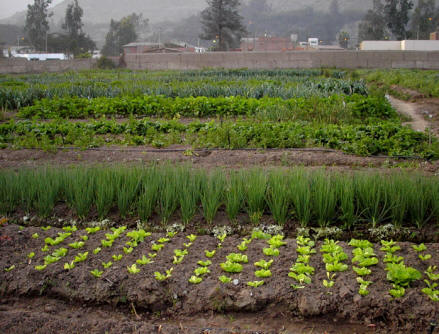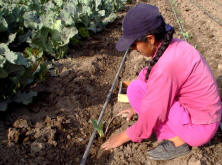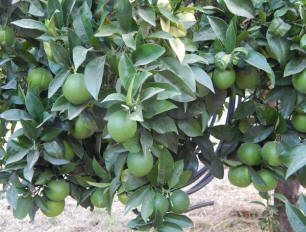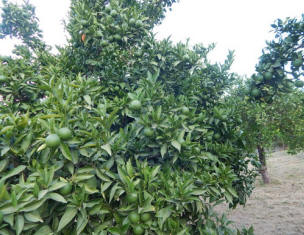|
|
|
Juan Rodríguez and Karina Ohme, the Guardians of Satsang, a farm where Homa Therapy is practiced, wrote:
Building together an Ark of Love and Service |
Homa Biogarden in the Farm of Eng. Mati Uranga, Lima, Peru
|
According to Homa agriculture, which comes from the Science of VRUKSHA AYURVEDA, more than 75% of the nutrition for the plant comes from the atmosphere. |
|||
|
|||
Homa Farm Shreedham, Algodonales, Andalusia, Spain
|
|
|||
|
Enzo Desto’s Story
Homa Farm: Hotel Cantayo
Nazca, Peru
South America
horticulture
medicinal herbs
cattle
The Cantayo farm has a wide variety of organic fruits, medicinal herbs and plants, also animals and much more – you have to visit and experience this unique atmosphere and you will be carried away by its beauty.
Continue reading “Enzo Desto’s Story”
Engineer Gilberto Navarro’s Story
Guayaquil, Ecuador
South America
tomatoes
Engineer Gilberto Navarro is Director of the Center of Organic Agriculture of the Government of the Province of Guayas, Ecuador.
“We decided to combine the technology of organic agriculture with the technology of Homa Farming when Maria de Belen Cajas, a University student, came for internship. She supplied the Agnihotra ash. She and her parents, the architects Alejandro and Estefania Cajas have been practising Agnihotra for many years.”
Continue reading “Engineer Gilberto Navarro’s Story”
Edgar Arevalo Patow’s Story
Homa Farm: Three Sisters
Aucayacu, Huanuco Region, Peru
South America
After six months application of Homa Therapy – TOTAL REJUVENATION!
“Before starting to work with Homa Therapy, my situation, similar to the one of any peasant from the High Huallaga region, was of total despair and one which people do not understand: I thought I no longer had any resource to heal my crops, since I tried all chemical substances that the Government agency supplied to me. Nothing worked. Plagues and diseases continued, and the yield of the crops continued to diminish each time more and more.”
Continue reading “Edgar Arevalo Patow’s Story”
Carlos Augusto Pajuelo’s Story
Homa Farm: El Cerezo
Piura, Peru
South America
mango
“I planted 10,000 Mango trees, variety Kent in 30 hectares in 1997. But we lost all the production in Piura with the climatic changes of “El Nino” in 1998. Banks were not giving loans either. However, in 2001, while I was the Director of the Office of the Ministry of Agriculture in Piura, I was fortunate to learn about the Agro Homa Supertechnology and decided to apply it in my farm.”
“The situation of the farm was critical, since there was not enough water, fertilization and appropriate management. The plantation was 4 years old with zero production. The Mango usually produces after 3 years. The following chart shows what happened with Homa application on my farm:”
Report from Tingo Maria, Peru, 1999
Translation from original Spanish document signed and sealed by the Ministry of the Presidency – INADE (National Institute of Development) Republic of Peru, Special project Alto Huallaga
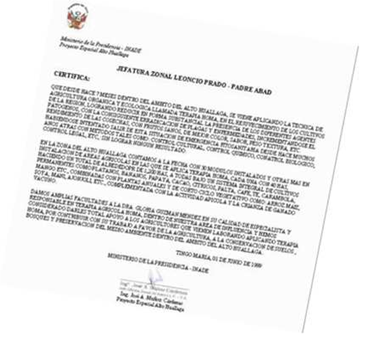
The Headquarters of the Zone Leoncio Prado-Padre Abad Certifies:
That since 7 months ago, in the area of Alto Huallaga, an Organic and Ecological technique called HOMA THERAPY, is being applied in the rejuvenation of the crops of the region, achieving to substantially reduce the existence of different pathogenic agents. As a consequence, plagues and diseases were eradicated, the yield of the harvest was increased, the fruit grew healthy, with better color, taste, weight, texture, etc.
Since many years, efforts have been made to overcome the critical situation regarding plant health, with methods such as: cultural control, chemical control, biological control, legal control, etc., without having achieved any success.
In the zone of Alto Huallaga to date we have established 30 modules and more are being installed in agricultural areas in which HOMA THERAPY is being applied, each one with 40 hectares. This makes a total of about 1,200 hectares; all of them are under an integrated system of perennial crops such as plantain, bananas, papaya, cocoa, citrus, avocados, coffee, tea, star fruit, mango, etc. These are combined with annual crops of a short vegetative cycle such as rice, corn, soya bean, nuts, sesame, etc., and complemented with apiculture and cattle rearing.
We give full support to Dr. Gloria Guzman Mendez in her capacity as expert and the person in charge of AGRICULTURAL HOMA THERAPY in our area of influence and we have considered to give total support to the farmers who have been working in the application of HOMA THERAPY because with their work, they are making a contribution in favor of agriculture, of the conservation of soils, forests and the preservation of the environment in the area of Alto Huallaga.
Tingo Maria, May 17th, 1999
MINISTRY OF THE PRESIDENCY-INADE
Special Project Alto Huallaga
(Signature)
_______________________
Engineer Jose A. Muñoz Cardenas
Chief, Support Office of the Zone L.P.-P.A.
Hernan Posas’ Story
Homa Farm: Fountain of Joy
Vinces, Ecuador
South America
banana
“I am an agronomical engineer working for the Department of Agriculture, in the Ecuadorian government. I am also General Manager of this farm. I have monitored the progress on this Homa Farm since 2007. These are my most recent observations.”
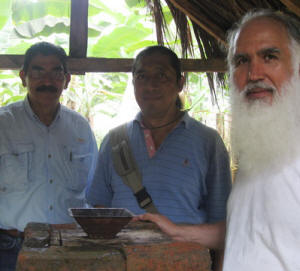 “Homa Farming has been applied in the banana plantation, Fountain of Joy (officially still called “Sorrows”) since 2007. It has 2 Homa Resonance Points installed with the respective cabins for the practice of Agnihotra and Om Tryambakam Homa.”
“Homa Farming has been applied in the banana plantation, Fountain of Joy (officially still called “Sorrows”) since 2007. It has 2 Homa Resonance Points installed with the respective cabins for the practice of Agnihotra and Om Tryambakam Homa.”
(photo from left: Hernan Posas, Andres Arango (in charge of Homa Therapy on the plantation) and Prof. Abel Hernandez in one of the Homa Resonance pillars surrounding the farm) Continue reading “Hernan Posas’ Story”
Maria Teresa Nuniez’ Story
Tenjo, Colombia
South America
fruit trees
medicinal herbs
“I would like to share an experience we had in the village of Tenjo, close to the capital, Bogota. There, we have a lot of different crops on our small farm. It is in our garden where we use all the techniques of Homa Therapy in the preparation of the land, in the irrigation, spraying Agnihotra ash water against bugs, etc., in short, all we can do with Homa Therapy.”
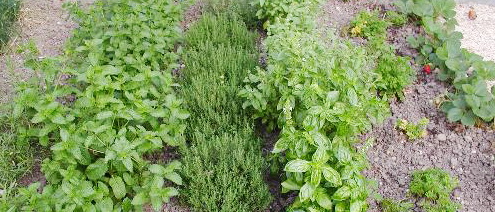
“And the truth is that in this time of drought and water shortage there has been an incredible response from the Homa garden as well as from the herbs and fruit trees … they continue to resist like warriors of Light, giving delicious fruits and showing that Homa Therapy works! We give all the Agnihotra ash which remains to the plants. Even though, we do Agnihotra only three times a week (nobody lives yet on the farm), these Homa fires are so generous!”



